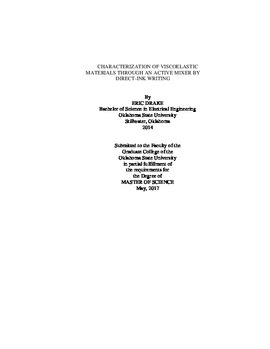| dc.contributor.advisor | Smay, James E. | |
| dc.contributor.author | Drake, Eric | |
| dc.date.accessioned | 2018-03-13T18:15:35Z | |
| dc.date.available | 2018-03-13T18:15:35Z | |
| dc.date.issued | 2017-05-01 | |
| dc.identifier.uri | https://hdl.handle.net/11244/54517 | |
| dc.description.abstract | Abstract: The goal of this thesis is two-fold: First, to determine mixing effectiveness of an active mixer attachment to a three-dimensional (3D) printer by characterizing actively-mixed, three-dimensionally printed silicone elastomers. Second, to understand mechanical properties of a printed lattice structure with varying geometry and composition. Ober et al defines mixing effectiveness as a measureable quantity characterized by two key variables: (i) a dimensionless impeller parameter (? ?) that depends on mixer geometry as well as Peclet number (Pe) and (ii) a coefficient of variation (COV) that describes the mixer effectiveness based upon image intensity. The first objective utilizes tungsten tracer particles distributed throughout a batch of Dow Corning SE1700 (two parts silicone) - ink �A�. Ink �B� is made from pure SE1700. Using the in-site active mixer, both ink �A� and �B� coalesce to form a hybrid ink just before extrusion. Two samples of varying mixer speeds and composition ratios are printed and analyzed by microcomputed tomography (MicroCT). A continuous stirred tank reactor (CSTR) model is applied to better understand mixing behavior. Results are then compared with computer models to verify the hypothesis. Data suggests good mixing for the sample with higher impeller speed. A Radial Distrubtion Function (RDF) macro is used to provide further qualitative analysis of mixing efficiency. The second objective of this thesis utilized three-dimensionally printed samples of varying geometry and composition to ascertain mechanical properties. Samples were printed using SE1700 provided by Lawrence Livermore National Laboratory with a face-centered tetragonal (FCT) structure. Hardness testing is conducted using a Shore OO durometer guided by a computer-controlled, three-axis translation stage to provide precise movements. Data is collected across an �x-y� plane of the specimen. To explain the data, a simply supported beam model is applied to a single unit cell which yields basic structural behavior per cell. Characterizing the sample as a whole requires a more rigorous approach and non-trivial complexities due to varying geometries and compositions exist. The data demonstrates a uniform change in hardness as a function of position. Additionally, the data indicates periodicities in the lattice structure. | |
| dc.format | application/pdf | |
| dc.language | en_US | |
| dc.rights | Copyright is held by the author who has granted the Oklahoma State University Library the non-exclusive right to share this material in its institutional repository. Contact Digital Library Services at lib-dls@okstate.edu or 405-744-9161 for the permission policy on the use, reproduction or distribution of this material. | |
| dc.title | Characterization of Viscoelastic Materials Through an Active Mixer by Direct-ink Writing | |
| dc.contributor.committeeMember | Bunting, Charles | |
| dc.contributor.committeeMember | Sarin, Pankaj | |
| dc.contributor.committeeMember | Vaidyanathan, Ranji | |
| osu.filename | Drake_okstate_0664M_15073.pdf | |
| osu.accesstype | Open Access | |
| dc.description.department | Materials Science and Engineering | |
| dc.type.genre | Thesis | |
| dc.type.material | text | |
